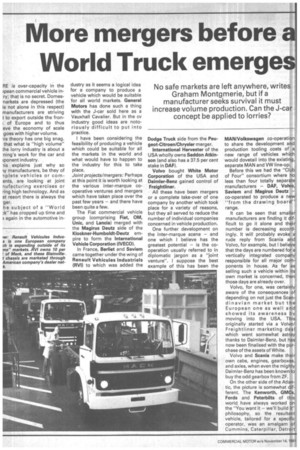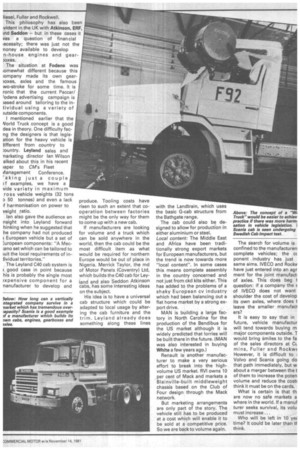More mergers before a World Truck emerges
Page 74

Page 75

If you've noticed an error in this article please click here to report it so we can fix it.
No safe markets are left anywhere, writes Graham Montgmerie, but if a manufacturer seeks survival it must increase volume production. Can the J-car concept be applied to lorries?
RE is over-capacity in the )pean commercial vehicle inTy; that is no secret. Domesnarkets are depressed (the is not alone in this respect) manufacturers are striving Ito export outside the fron; of Europe and to thus eve the economy of scale goes with higher volume.
is theory has one big snag. that what is "high volume" (he lorry industry is about a ning's work for the car and iponent industry.
iis explains just why so ly manufacturers, be they of iplete vehicles or cornents, are looking at joint lufacturing exercises or ring high technology. And as st resort there is always the • ger.
he subject of a "World 7.1<" has cropped up time and 3 again in the automotive in
dustry as it seems a logical idea for a company to produce a vehicle which would be suitable for all world markets. General Motors has done such a thing with the J-car sold here as a Vauxhall Cavalier. But in the cv industry good ideas are notoriously difficult to put into practice.
I have been considering the feasibility of producing a vehicle which could be suitable for all the markets in the world and what would have to happen to the industry for this to take place.
Joint projects/mergers: Perhaps at this point it is worth looking at the various inter-marque cooperative ventures and mergers which have taken place over the past few years — and there have been quite a few.
The Fiat commercial vehicle group (comprising Fiat, OM, Unic, and Lancia) merged with the Magirus Deutz side of the Klockner-Humboldt-Deutz empire to form the International Vehicle Corporation (IVECO).
In France, Berliet and Sayiem came together under the wing of Renault Vehicules Industriels (RV!) to which was added the
Dodge Truck side from the Peugeot-Citroen/Chrysler merger.
International Harvester of the USA wholly owns Seddon Atkinson (and also has a 37.5 per cent stake in DAF).
Volvo bought White Motor Corporation of the USA and Daimler-Benz gained control of Freig htliner.
All these have been mergers or a complete take-over of one company by another which took place for a variety of reasons, but they all served to reduce the number of individual companies concerned in vehicle production.
One further development on the inter-marque scene — and one which I believe has the greatest potential — is the cooperation usually referred to in diplomatic jargon as a "joint venture". I suppose the best example of this has been the MANNolkswagen co-operation to share the development and production tooling costs of a new range of vehicles which would dovetail into the existing, separate MAN and VW line-up.
Before this we had the "Club of Four" consortium where no less than four totally separate manufacturers — DAF, Volvo, Saviem and Nlagirus Deutz — co-operated to produce a new "from the drawing board" range.
It can be seen that smaller manufacturers are finding it difficult to go it alone and their number is decreasing accordingly. It will probably evoke a rude reply from Scania and Volvo, for example, but I believe that the days are numbered for a vertically integrated company responsible for all major components in house. As far as selling such a vehicle within its own market is concerned, then those days are already over.
Volvo, for one, was certainly aware of the consequences of depending on not just the Scandinavian market but the European one as well and showed its awareness by moving into the USA. This originally started via a Volvo/ Freightliner marketing deal which went somewhat astray thanks to Daimler-Benz, but has now been finalised with the purchase of the assets of White.
Volvo and Scania make their own cabs, engines, gearboxes, and axles, when even the mighty Daimler-Benz has been known to buy the odd gearbox from ZF.
On the other side of the Atlantic, the picture is somewhat different. The Kenworth, GMCs, Fords and Peterbilts of this world have always worked on the "You want it — we'll build it" philosophy, so the resultant vehicle, tailored for a specific operator, was an amalgam of Cummins, Caterpillar, Detroit )iesel, Fuller and Rockwell.
This philosophy has also been :vident in the UK with Atkinson, ERF, Ind Seddon — but in these cases it vas a question of financial lecessity; there was just not the noney available to develop n-house engines and gear)oxes.
The situation at Fodens was ;omewhat different because this ;ompany made its own gear)oxes, axles and the famous wo-stroke for some time. It is ronic that the current Paccar/ 'odens advertising campaign is )ased around tailoring to the iniividual using a variety of )utside components.
I mentioned earlier that the World Truck concept is a good dea in theory. One difficulty facng the designers is that legisation for the heavy vehicle is Efferent from country to ..;ountry. Leyland sales and narketing director Ian Wilson alked about this in his recent )ape r to CM's Fleet Vlanagement Conference. -aking just a couple ) f examples, we have a vide variety in maximum ross vehicle weights (32 tons D 50 tonnes) and even a lack if harmonisation on power to veight ratio.
Ian also gave the audience an nsight into Leyland forward hinking when he suggested that he company had not produced European vehicle but a set of European components: "A Meolamp set which can be tailored to ;uit the local requirements of inlividual territories."
The Leyland C40 cab system is ) good case in point because his is probably the single most )xpensive component for a nanufacturer to develop and produce. Tooling costs have risen to such an extent that cooperation between factories might be the only way for them to come up with a new cab.
If manufacturers are looking for volume and a truck which can be sold anywhere in the world, then the cab could be the most difficult item as what would be required for northern Europe would be out of place in Nigeria. Merrick Taylor, the md of Motor Panels (Coventry) Ltd, which builds the C40 cab for Leyland and also Seddon Atkinson cabs, has some interesting ideas on the subject.
His idea is to have a universal cab structure which could be adapted to local usage by altering the cab furniture and the trim. Leyland already does something along these lines with the Landtrain, which uses the basic G-cab structure from the Bathgate range.
The cab could also be designed to allow for production in either aluminium or steel.
Local content: The Middle East and Africa have been traditionally strong export markets for European manufacturers, but the trend is now towards more "local content". In some cases this means complete assembly in the country concerned and not just from ckd kits either. This has added to the problems of a shaky European cv industry which had been balancing out a flat home market by a strong export drive.
MAN is building a large factory in North Carolina for the production of the Bendibus for the US market although it is widely predicted that lorries will be built there in the future. (MAN was also interested in buying White a few years ago.) Renault is another manufacturer to make a very serious effort to break into the highvolume US market. RVI owns 10 per cent of Mack and markets a Blainville-built middleweight chassis based on the Club of Four design through the Mack network.
But marketing arrangements are only part of the story. The vehicle still has to be produced at a cost which will enable it to be sold at a competitive price. So we are back to volume again. The Search for volume is confined to the manufacturer: complete vehicles; the cc ponent industry has just same aims. IVECO and Rocky have just entered into an agr ment for the joint manufact: of axles. This does beg I question: if a company the 5 of IVECO does not want shoulder the cost of develop its own axles, where does I leave the smaller manufaci ers?
It is easy to say that in future, vehicle manufactur will tend towards buying m major components outside. T would bring smiles to the fa of the sales directors at CL mins, Fuller and Rockw( However, it is difficult to Volvo and Scania going do that path immediately, but w about a merger between the t of them to increase the paten volume and reduce the costs think it must be on the cards.
What is certain is that th are now no safe markets a where in the world. If a manuf turer seeks survival, its volu must increase ...
Who will be left in 10 yeE' time? It could be later than tf think.






















































































